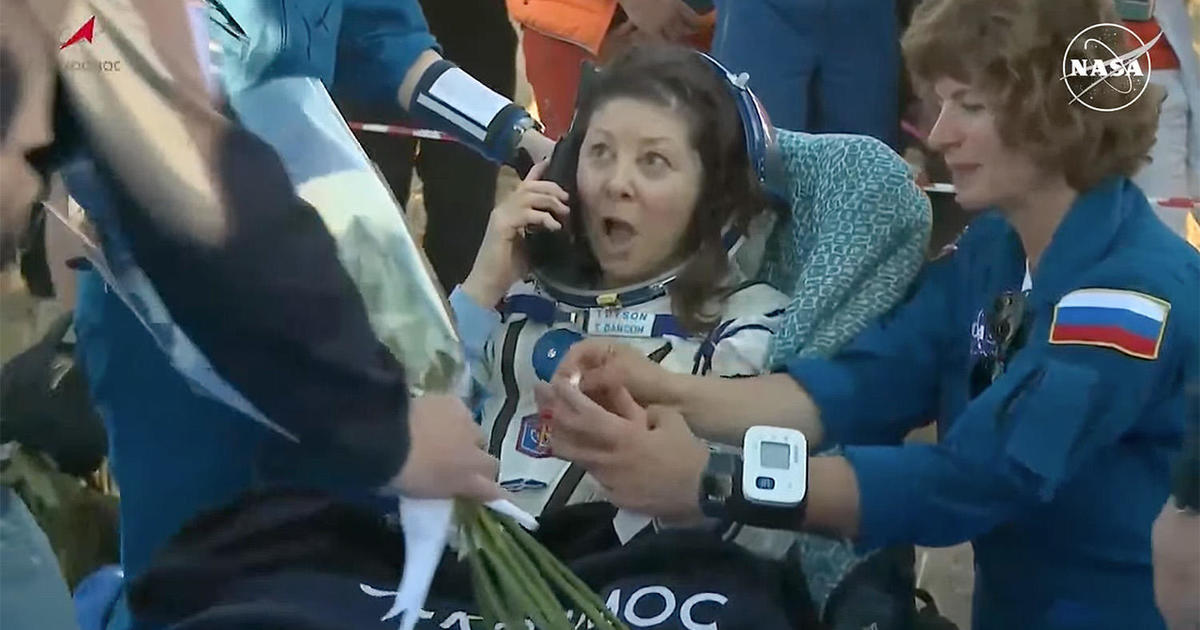Cosmonaut Oleg Kononenko, now the world’s most experienced spaceman, first-time flier Nikolai Chub and NASA veteran Tracy Dyson undocked from the International Space Station and returned to Earth Monday, closing out a record-setting mission with a picture-perfect landing in Kazakhstan.
With the Soyuz crew back home, NASA and SpaceX are gearing up to launch astronaut Nick Hague and cosmonaut Alexander Gorbunov to the station aboard a Crew Dragon capsule on Thursday, weather permitting. Liftoff from pad 40 at the Cape Canaveral Space Force Station is targeted for 2:05 p.m. EDT.
Hague and Gorbunov plan to join Starliner astronauts Barry “Butch” Wilmore and Sunita Williams aboard the lab, along with newly-arrived cosmonauts Alexsey Ovchinin, Ivan Vagner and NASA’s Donald Pettit.
Four other station crew members — Crew 8 commander Matthew Dominick, Mike Barratt, Jeanette Epps and cosmonaut Alexander Grebenkin — are nearing the end of their own six-month tour of duty and plan to return to Earth aboard another Crew Dragon spacecraft in early October.
But first, the Russians needed to bring Kononenko, Chub and Dyson back to Earth after a marathon mission.
The Soyuz MS-25/71S spacecraft undocked from the station at 4:36 a.m. EDT Monday. Plunging back into the discernible atmosphere along a southwest-to-northeast trajectory, the spacecraft descended through a cloudless blue sky under a large red-and-white parachute, touching down on the steppe of Kazakhstan at 7:59 a.m. EDT (4:59 p.m. local time).
Russian recovery crews and flight surgeons, including NASA support personnel, were on the scene within minutes to help the returning station fliers out of the cramped Soyuz descent module for initial medical checks and satellite phone calls home to family and friends.
With landing in Kazakhstan, Dyson logged 184 days in orbit since launch last March 23. Kononenko and Chub, launched aboard a different Soyuz last Sept. 15, put in more than a full year in space — 374 days — the longest stay yet aboard the International Space Station.
Including four earlier trips to the lab, Kononenko’s cumulative time in space now totals 1,111 days, 233 days more than the 878-day mark set by the previous record holder, cosmonaut Gennady Padalka.
All station fliers exercise extensively, on a daily basis, to maintain muscle mass and bone density in the weightless environment of space. But returning long-duration fliers typically need several weeks to fully re-adapt to the effects of gravity.
Even so, all three Soyuz crew members appeared healthy, flashing broad smiles after being pulled from the descent module and carried to nearby recliners. Dyson, who flew to the station with a different crew last March, was presented with a bouquet of flowers by her former commander, Oleg Novitskiy, much to her obvious surprise and delight.
During a change-of-command ceremony Sunday, Kononenko, the outgoing station commander, turned the outpost over to Williams, who arrived at the lab June 6 aboard Boeing’s Starliner spacecraft. She served as commander of the ISS the last time she was aboard the lab in 2012.
Williams and Wilmore are spending an unexpected eight-and-a-half months aboard the station because of helium leaks and thruster issues that prompted NASA to bring the Boeing spacecraft back to Earth Sept. 7 without its crew.
“Expedition 71 has taught all of us a lot about flexibility,” Williams told her crewmates, referring to the Starliner and its impact on station operations. “You adopted Butch and I even though that was not quite the plan. But here we are as part of the family. … We appreciate it.”
To Kononenko, she said “Oleg, we’ll miss your hundreds of stories around the dinner table. But I guess that’s what you get for having over 1,000 days in space, you get those stories, right?”
She told Chub the station crew will “miss your precision, your professionalism, but I guess that’s what you get when you sign up for your rookie flight (for) over a year in space. And Tracy, we’re going to miss your … organization, and your ability to make order out of chaos. So we thank you, all three of you, for that.”
The addition of the Starliner’s crew to the space station roster threw a wrench into a carefully orchestrated sequence of planned Soyuz and SpaceX Crew Dragon flights to and from the station intended to replace the lab’s seven full-time crew members.
NASA originally intended to start the latest crew rotation by launching the next Crew Dragon flight in August, sending Crew 9 commander Zena Cardman, Stephanie Wilson, Hague and Gorbunov to the lab to replace Dominick and his crewmates.
But the Crew 9 flight was held up, and the Crew 8 mission extended, while NASA managers debated whether Boeing’s Starliner capsule, launched June 5 on the ship’s first piloted test flight, could safely bring Wilmore and Williams home.
Playing it safe, agency managers decided on Aug. 24 to keep the Starliner astronauts on board the station for an extended stay and to bring the Boeing spacecraft back to Earth by remote control. That left the Crew Dragon as the only ship available to take Wilmore and Williams back to Earth.
To free up two seats for the Starliner crew, NASA bumped Cardman and Wilson from the Crew 9 roster. In the meantime, four days after the Starliner’s unpiloted return to Earth on Sept. 7, the Russians launched Ovchinin, Vagner and Pettit to replace Kononenko, Chub and Dyson.
Hague and Gorbunov are now scheduled for launch Thursday afternoon from the Cape Canaveral Space Force Station. The four Crew 8 fliers — Dominick, Barratt, Epps and Grebenkin — plan to return to Earth around Oct. 4.
Hague, Gorbunov, Wilmore and Williams are now expected to come home around Feb. 22 aboard the Crew 9 Dragon.




